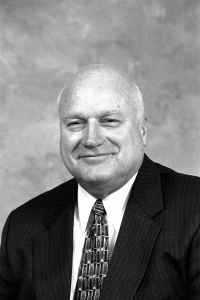This post is part of The Plank Center’s Legacies from Legends in PR Series that was begun in recognition of the 40th Anniversary of the Public Relations Student Society of America in 2007.
Taught public relations for 36 years at the University of Maryland. Authored six books and 240 other publications. Lectured in over 40 countries. Received multiple academic and scholarly awards, including PRSA’s Outstanding Educator Award (1989) and the Institute for Public Relations’ Pathfinder Award (1984) and Alexander Hamilton Medal (2005).
I believe that education in public relations and mastery of the ever-enlarging body of research-based knowledge in our discipline are the most important characteristics of today’s best public relations professionals. Public relations began as a trade in which anyone could claim expertise. The result was an undefined and misunderstood practice in which few practitioners took either ethics or the effectiveness of what they did seriously. Leaders such as Edward Bernays, Arthur Page, Earl Newsom, Scott Cutlip, Betsy Plank and Patrick Jackson changed public relations practice to base it on social scientific theories as well as knowledge from humanities. Academic scholars in public relations now have conducted enough high-quality research to make it both a respected profession as well as a respected academic discipline.
Based on this research, I have come to understand public relations as a strategic management function that uses communication to cultivate relationships with publics that have a stake in the behavior of the organization– either because they benefit from or are harmed by the consequences of that behavior. Public relations has value to an organization because it provides publics with whom it develops relationships a voice in management decisions that affect them. If public relations provides publics a voice in strategic decision-making, management is more likely to make socially responsible decisions. Responsible organizational behaviors, in a reciprocal manner, improve the quality of relationships with publics.
Quality relationships have both financial and non-financial value because they reduce the costs of regulation, legislation and litigation; reduce the risk of implementing decisions; and sometimes increase revenue. They also have the secondary effects of improving the reputation of an organization (what members of a public think about it) and reducing negative publicity because there are fewer bad behaviors for journalists to write about. The only way to “manage a reputation” is through managing the organizational behaviors that are reflected in that reputation.
If public relations is a process of cultivating relationships with publics, then the values of the profession should reflect a worldview that is likely to produce good relationships. I believe that the primary value of public relations is a simple one – a value I learned in the rural Midwest – that is embraced by most religions of the world, and whose absence has produced wars and civil unrest throughout human history. That value is concern for others as well as ourselves. It is reflected in what I have called the symmetrical model of public relations, which suggests that public relations should strive to balance the interests of publics with the interests of the organization.
Research also shows that organizations that interact with their publics responsibly are also the most successful. In addition, symmetrical public relations helps society at large by improving parts of the web of relationships that makes up society. The symmetrical value of concern for others as well as ourselves also makes public relations a profession. A profession, by definition, is concerned with the greater good as much or more than self-interest.
The challenge for the next generation of public relations professionals – those of you who now are members of PRSSA – is to practice public relations in this responsible way, explain its values to organizations and people in general and, as a result, gain respect for this important profession throughout the world.
Published: 2007
